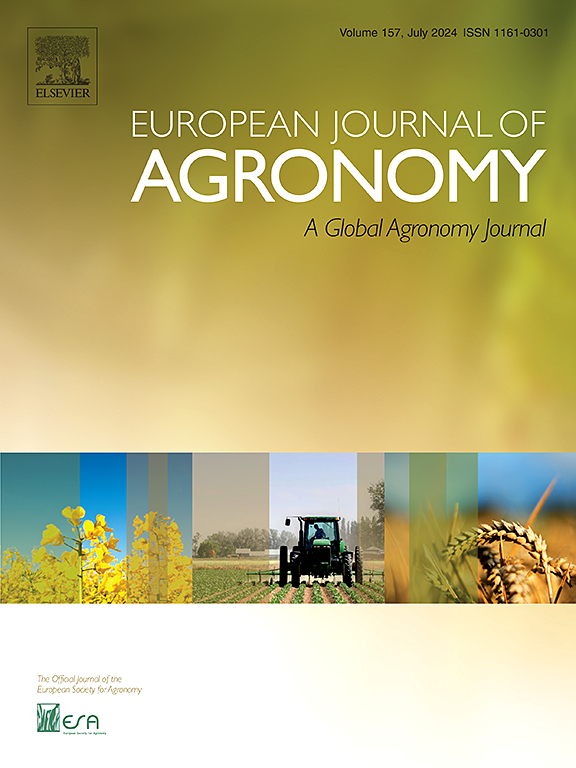高密度种植下棉铃叶系统间光合功能的协调维持棉铃重
IF 4.5
1区 农林科学
Q1 AGRONOMY
引用次数: 0
摘要
较高的种植密度对单株铃数的影响比单铃重的影响更显著,但随着棉铃脱落的增加,单叶光合作用对单株铃重的影响难以估计。我们推测,高的植株密度可能导致光合器官之间的协调来维持铃重。因此,对不同密度下棉花的产量形成、叶片光合特性和铃叶系统进行了研究。结果表明:随着植株密度的增加,单株铃数或铃叶系铃数的下降幅度大于单株铃叶系铃数的下降幅度;随着株密度的增加,铃叶系统的叶面积、单叶光合速率和CO2同化均逐渐降低。铃叶系统CO2综合同化与每铃叶系统铃生物量呈显著的线性正相关。随着株密度的增加,剥皮处理后铃叶系统的铃生物量比未剥皮处理的下降幅度更大。在19 ~ 25株m−2时,铃叶系统铃生物量的环生/非环生达到0.8 ~ 1.0。下冠层棉铃的去除导致上冠层棉铃生物量显著增加,且高密度(25株m−2)下的每铃生物量比低密度下的增加幅度更大。因此,随着植株密度的增加(<;25株m−2),铃叶系统CO2同化的迅速减少导致每铃叶系统铃数减少。在高密度条件下(>;25株m−2),棉铃生物量不仅取决于相应铃叶系统的光合速率,还取决于相邻铃叶系统间光合功能的协调。最佳种植密度为19 ~ 25株m−2,说明铃叶系统中同化物的生产和利用能够达到平衡。在此密度下,铃数和铃重的协调有利于单株和单位地面积产量的最大化。本文章由计算机程序翻译,如有差异,请以英文原文为准。
Enhanced coordination of photosynthetic functions among cotton boll–leaf systems to maintain boll weight under high-density planting
High planting density curtails the boll number per plant more significantly than the single boll weight, yet it is hard to estimate the boll weight from single-leaf photosynthesis with increasing boll abscission. We speculated that high plant density may lead to coordination among photosynthetic organs to maintain boll weight. Therefore, cotton (Gossypium hirsutum L.) yield formation, the photosynthetic characteristics of the leaves and boll–leaf system were studied under various plant densities. The results showed that the boll number per plant or boll number per boll–leaf system decreased more greatly than the boll–leaf system number per plant with increasing plant density. Leaf area, single leaf photosynthetic rate, and CO2 assimilation of the boll–leaf system all gradually decreased with the increase of plant density. There was a significant positive linear correlation between integrated CO2 assimilation of the boll–leaf system and boll biomass per boll–leaf system. After girdling treatment, the boll biomass of the boll–leaf system decreased more greatly compared with non-girdling treatment with increasing plant density. Moreover, the girdling/non-girdling of boll biomass per boll–leaf system reached 0.8–1.0 at 19–25 plants m−2. The removal of the lower-canopy bolls caused a significant increase in the boll biomass of the upper canopy, and the biomass per boll at high densities (>25 plants m−2) increased more greatly than at low densities. Therefore, the rapid decrease in CO2 assimilation of the boll–leaf system resulted in a decreased boll number per boll–leaf system as plant density increased (<25 plants m−2). Under high densities (>25 plants m−2), the boll biomass not only depends on the photosynthetic rate of the corresponding boll–leaf system, but also on the coordination of photosynthetic functions among adjacent cotton boll–leaf systems. Optimal planting density (19–25 plants m−2) means that the assimilate production and utilization of the boll–leaf system can be balanced. At this density, the coordination of boll number and boll weight is conducive to maximizing the yield per plant and unit ground area.
求助全文
通过发布文献求助,成功后即可免费获取论文全文。
去求助
来源期刊

European Journal of Agronomy
农林科学-农艺学
CiteScore
8.30
自引率
7.70%
发文量
187
审稿时长
4.5 months
期刊介绍:
The European Journal of Agronomy, the official journal of the European Society for Agronomy, publishes original research papers reporting experimental and theoretical contributions to field-based agronomy and crop science. The journal will consider research at the field level for agricultural, horticultural and tree crops, that uses comprehensive and explanatory approaches. The EJA covers the following topics:
crop physiology
crop production and management including irrigation, fertilization and soil management
agroclimatology and modelling
plant-soil relationships
crop quality and post-harvest physiology
farming and cropping systems
agroecosystems and the environment
crop-weed interactions and management
organic farming
horticultural crops
papers from the European Society for Agronomy bi-annual meetings
In determining the suitability of submitted articles for publication, particular scrutiny is placed on the degree of novelty and significance of the research and the extent to which it adds to existing knowledge in agronomy.
 求助内容:
求助内容: 应助结果提醒方式:
应助结果提醒方式:


